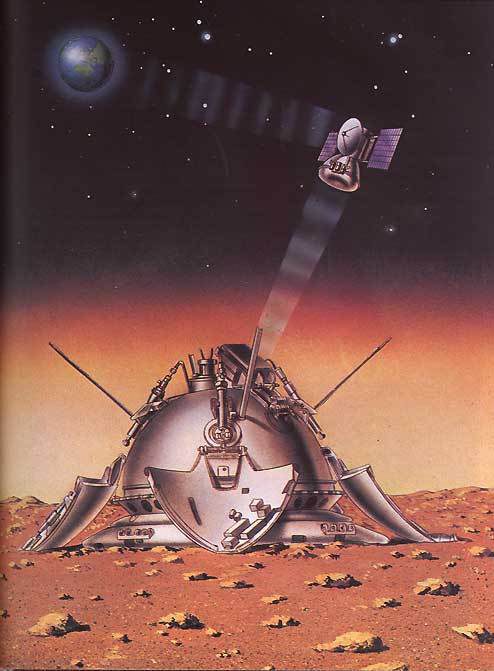Emily Lakdawalla • Apr 12, 2013
Russia's Mars 3 lander maybe found by Russian amateurs
It's fitting, on the anniversary of Yuri Gagarin's pioneering flight into orbit, to be writing about the possible discovery of Russian space hardware on the surface of Mars. The fact that it may have been found by Russian space enthusiasts is just icing on the cake. Much of the following text is translated from a blog entry by the Russian amateur, Vitaliy Egorov, who located specks on a Mars Reconnaissance Orbiter image that just might be the Mars 3 lander.
Vitaliy didn't discover what could be Mars 3 without help; as he explains below, he had help from other amateurs participating in the search in a group on Vkontakt, the Russian Facebook. And the dot that may be Mars 3's parachute was actually found by another searcher, who goes by the name Imxotep on another forum, novosti-kosmonavtiki.
But as you'll see below, it's Vitaliy's persistence (and the fact that he listened to skeptical experts who required that he strengthen the case) that resulted in yesterday's announcement. The reason that this story is different from those of the countless people who have emailed me informing that they have discovered crashed hardware on Mars is because of Vitaliy's methodical approach to making a strong case. And that he admits that for all that it is a good circumstantial case, and that he wants to shout from the rooftops the fact that he discovered Mars 3, it could still just be a suggestive shadow.
Most of the below is from a blog entry that Vitaliy posted here. I ran it through Google translate and did my best to edit it into grammatical English, working with Vitaliy to make sure the sense was correct. I provide some extra context and commentary in [brackets and italics].
Vitaliy Egorov
Виталий Егоров (Vitaliy Egorov) is a journalist, enthusiast and popular writer about space research. He is the founder of the largest community devoted to MSL Curiosity on Vkontakte (Russian facebook). He participates on unmannedspaceflight.com as Zelenyikot.
How we searched for Mars 3
Honestly, it happened almost by accident that this news comes at the beginning of April, on Cosmonautics Day. This story began and ended over 40 years ago -- and is suddenly being continued today. How the simple users of VKontakte [Russian Facebook], in their enthusiasm for Mars, helped out NASA. And the fact that the international solidarity of scientists is not an empty phrase. And that space is closer than you think.
We were looking for Mars 3. And we found it! Right on Mars, at the bottom of a giant crater named Ptolemy, among barren wasteland and boulders. How did we do it? Here is the story.
It all started on Habr [an online forum].
No, it really started long ago, of course, on May 28, 1971, when the Soviet Union launched to Mars the scientific lander Mars-3. But for me it all started on Habr in late November 2012, with one half-joking comment on a NASA photo: "They've found an old Soviet rover..." At that time, I was sure that all the "old rovers" had long been found, that we knew the places of their landings. But when I checked the HiRISE site I was surprised to discover that nothing had been found!
They knew the location of all successful landers, and had photographed them all with the HiRISE camera on the satellite Mars Reconnaissance Orbiter, at a detailed resolution of 30 centimeters per pixel. But with failures, the solutions were not unique. The Americans' Mars Polar Lander, the Europeans' Beagle 2, the Soviet Union's Mars 6 and Mars 2 -- none of them had been found, despite searching. And what about Mars-3? It turned out that he, too, had not been seen.
Our device, which made a phenomenal achievement, the first-ever successful landing on another planet, more than 40 years ago! He did it in almost the same sequence as in 2012, the Americans put Curiosity on the ground. See for yourself:
(I love this video. Back then Russia could fly spaceships and shoot movies.)
So, Mars 3 settled down successfully -- this is known for sure, because he began a radio broadcast from the surface, and this would have been impossible without the antenna opening. But after 14 seconds, the broadcast ended, leaving the puzzle of why for the designers, and the puzzle of the first-ever picture of Mars for space enthusiasts with Photoshop. If you look, and use your imagination, you can see a skyline, mountain slopes and Martian clouds and clouds of dust from the raging storm.

But no. The catch is that this is part of a panorama, and to view it in its proper perspective, in which the camera was filming, the scene should be rotated 90 degrees. As conceived by the designers, the photograph was supposed to look something like this:
If we superimpose them, you get:

[I want to interject an editorial comment here that there is a lot of Internet debate over the Mars-3 "image" transmission and whether it contains only noise or if it has image information; perhaps the spacecraft was lying on its side; and so on. Here is some conversation about that at unmannedspaceflight.com, and Ted Stryk's opinion on his website.]
No valuable information from the surface was transmitted. The first rover did not set foot on the surface of Mars, as it was still attached to the top of the module. [There is actually debate about this, too -- in a 1990 article written for The Planetary Report, Charlene Anderson reports that the rover designer Alexander Kermurjian thinks it may well have set its treads on Mars. There's no way of knowing without higher-resolution images.] But a psychological victory was achieved: the first to put our hardware on another planet! Why it shut down, we do not know. Eventually, future settlers will answer this question.
Then there were other expeditions, other successes and failures, and all the while the metal "flower" was gradually sinking into oblivion. Generations changed, as did the state. There was the Internet, and Facebook. And then I got interested in Mars-3.
Turning to the HiRISE website, I found only a single image from 2007, called Center of Soviet Mars 3 Landing Ellipse. It was a discovery for me, because I was convinced of the omnipotence of NASA and HiRISE. I expected to see a clear indication of the location of our lander. A quick web search also did not yield any results. It was obvious that the Mars-3 had not been found. I downloaded the full-length shot (1.3 GB), opened it and saw why in 5 years so no one has found the lander.
Imagine a search on the rectangle 6 kilometers wide by 20 kilometers long for a circular object with a width of 1.5 meters. I know many people are thinking that I had to write a program that she would be looking for a station. But I think, such a search is not possible until you create artificial intelligence. Yes, the program could provide interesting boulders of appropriate size.
But there are thousands of such objects - like in this fan of debris from a crater.
The whole image contains 2 billion pixels, within which it is necessary to find an object 8 by 8 pixels in size. Here is a fragment at the full resolution:
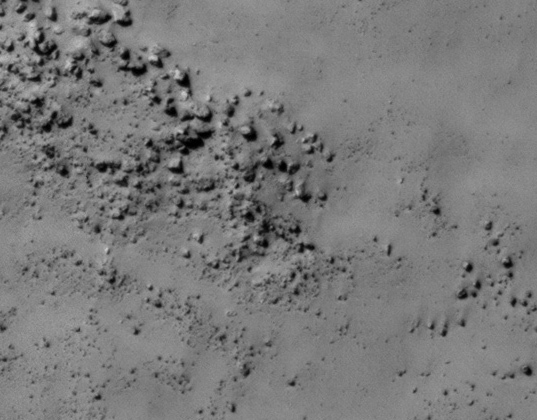
I looked at this and realized the work would not succeed without the help of a collective mind. By this time the Vkontakt group "Curiosity - Mars rover" had about four thousand members, and I offered to subscribers the patriotic quest to find Mars 3. For this, I divided the big photo into 20 parts, loaded them into a network and invited all interested to take part in the search. A dozen enthusiasts responded. They began to find pieces and loaded into a separate album the most interesting findings. We found a lot of interesting spots, but none of them is an exact match:
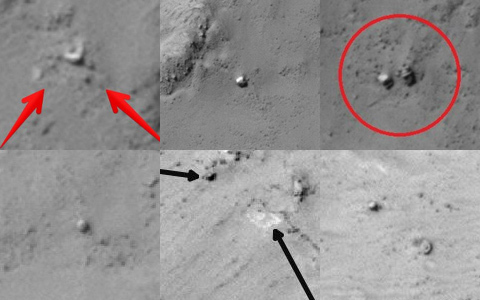
By its location and shape, the object in the lower right corner could with some confidence be identified as the brake cone or, in the terminology of NASA, the heat shield. Americans agreed with this suggestion, with the caveat that "alternative explanations for the features cannot be ruled out." The item was found by two members: Ya Zaero and Aku Neko.
As soon as we started looking, participants with better Google skills, found a link on the forum Novosti Kosmonautiki ("Space News"), in which the user Imhotep posted this image crop, which possibly shows the parachute of Mars-3.
But we finished searching the entire field of the picture, and the rest of Mars-3 was not found. To test, I placed all of the interesting findings in the small scale of the map, to see if there is any connection between them. Only the parachute and braking cone were close, but I did not attach any importance to this at the time.
Then I decided to "dance on the stove," ["begin at the beginning"], and focus on the parachute. That is, I assumed that the feature that Imxotep had identified, really was the parachute. I did not know how far from the parachute the rest of the other elements could scatter. So I looked at the hardware for the American missions: Viking 1 and 2, Phoenix Lander, and Mars Pathfinder, superimposed them on the landing of Mars-3, and drew a maximum radius, for the distance reached by objects that had flown under NASA's parachutes. The most interesting objects I placed on a separate layer, broadly according to their relative position on the ground. I produced the following picture:
But I ran out of steam to locate the missing parts. I never finished the scheme, and, as it turned out, my search radius did not include the landed elements - our unit scattered more than the American ones.
I contacted the Canadian scientist Philip Stooke. At the time, he was looking for (but had mistakenly identified) Lunokhod 2 in Lunar Reconnaissance Orbiter pictures. [Here is the Lunokhod 2 story.] He offered some advice, which proved crucial: the direction of the flight landing module. He said: "The flight was to the east." This immediately cut off 50% of the image, concentrating the search in the optimal direction.
I selected sectors, which covered a radius four times beyond the range that American hardware had flown, and continued to methodically view the frame. It took a few nights, and to be honest, I didn't expect to find anything; I continued simply from a desire to pursue the case. When I announced the massive search, I pledged that the efforts of the people will not be spent for nothing, although I warned that the probability of detection is very low. I had to check to be able to say with confidence, "Cannot be found!" or "Found!"
The result: "Found!"
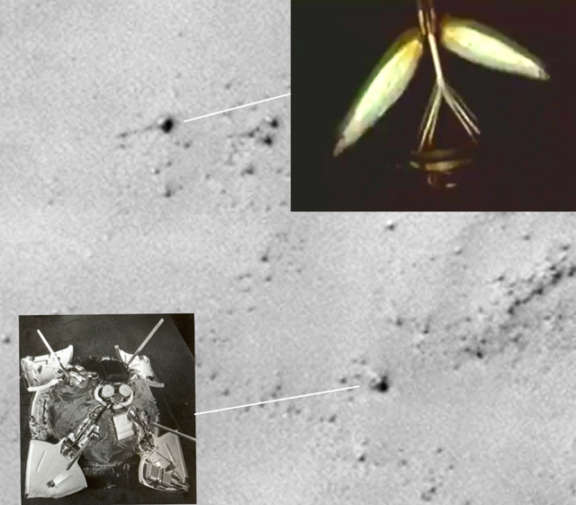
I initially focused my search on the lander, and on his cross "petals." That is how I recognized the object. The soft-landing engine, coupled to the parachute container, which I discovered nearby, was a bonus. I watched the movie again, but then the detail "disappeared" before landing, so I did not see it. The final stages of landing took place in the following sequence:
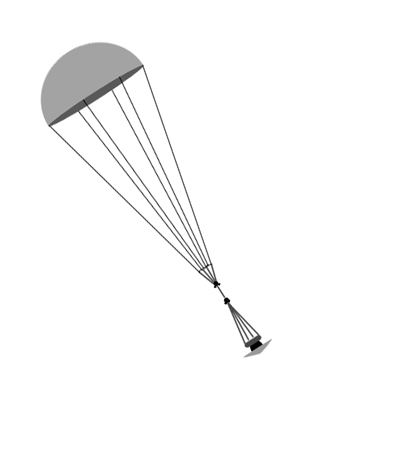
So, I found it! But what next?
I could write about it on Habr, or on the "Space News" forum, but there were already so many searchers there who saw Mars-3 in every mound, and in every sand dune, the parachute. I needed more proof.
Here again, Phil helped. He looked my discovery, agreed that it was very interesting, and advised that I look around for a few objects that had size and shape similar to the descent module. This had to be done in order to show that my discovery was the most convincing.
I did it, and got this sheet:

(Actually, I had two such sheets, I'm just showing one here.) The number 1 item is the most convincing candidate for Mars-3. Of course, this sample is not really representative at all, since it was drawn up, when I already knew the answer. But I tried to select the most similar features. Fortunately there were not many large heaps of stones in the search sector.
But this is only one argument in favor of my finds. It was necessary to find a more convincing proof, but I could not do it alone. We needed another picture area at a different time of day to change the nature of the shadows to define the shape of objects. It was necessary to obtain information about the length of the cable that connected the parachute container with the backshell and its soft-landing rocket motors. The latter point could not only confirm, but also refute my guess, which is consistent with Popper's criterion that must be met for all scientific theories. Its observed length was 4.8 meters. If a discrepancy was found of more than a meter, the honor of the discovery could be forgotten.
This raises the question, could such a thin rope be visible in pictures that have a resolution of 25 centimeters per pixel? Well, if you look at a picture of Opportunity, you can see the shadow of his mast:
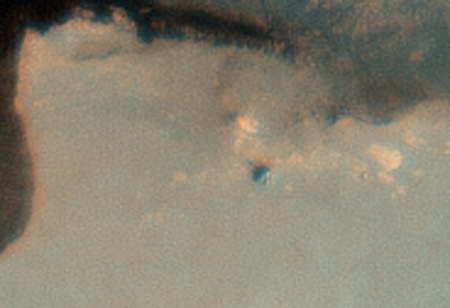
Although in reality it is no wider than 15 centimeters.
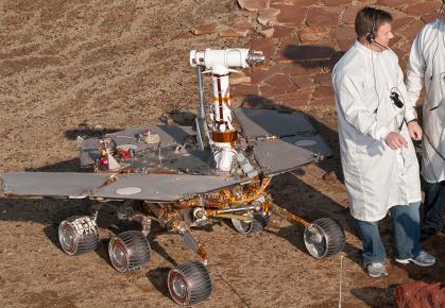
So HiRISE should not even be able to see that. However, the cable could not be 15 centimeters wide; it must be narrower.
HiRISE had viewed this site only once. I could not find information on the length of the cable in any available sources. The most informative source is the book "Difficult Road to Mars" [PDF] by VG Perminov (incidentally, published by NASA and in English). But even there, the necessary information was not found.
So I turned to the Head of the Laboratory of Comparative Planetology of the Institute of Geochemistry and Analytical Chemistry, Vernadsky Institute, Alexander Basilevsky. He had been listed as a reference on the Wikipedia article on Lunokhod-2, so I thought that he would be interested in the Martian theme. At first he was skeptical: "You have to make a case: why do you think that this object is what you think? The argument that one of my friends used once: 'Only a blind man cannot see it!' -- will not pass."
I prepared a diagram that displayed all that I saw, and how I saw it:
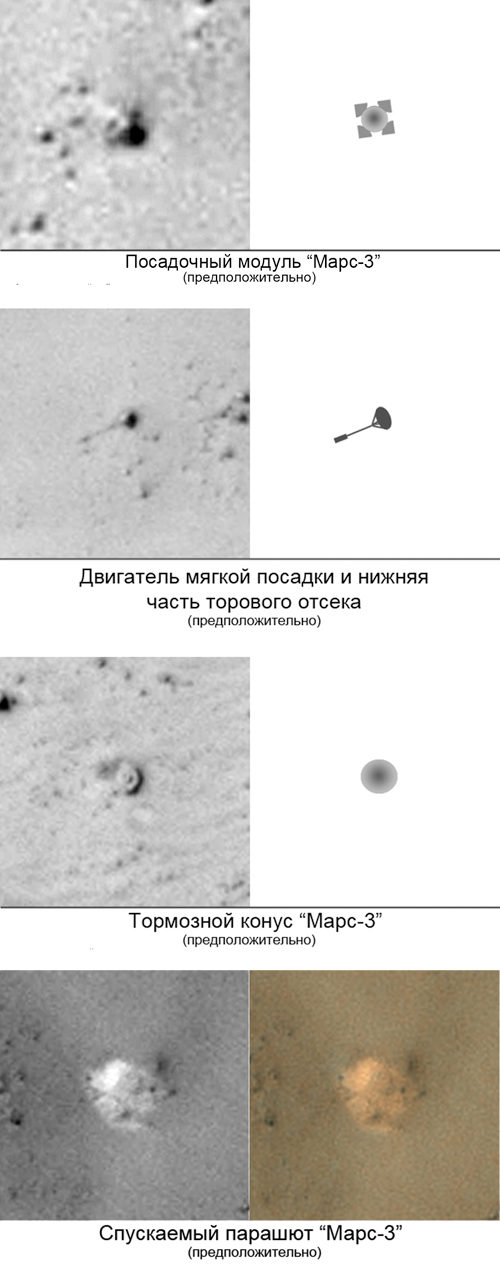
And I thought it was pretty convincing! Of course, as any good scientist, Alexander Tikhonovich remained skeptical, and always referred to these in his correspondence as "elements of Mars-3, as seen by Vitaliy." But he wrote the head of the HiRISE team, Alfred McEwen.
The American response was swift and unexpected for me: "We will re-image this location to see if we can learn more."
That's it! I do not know whether my illustrations were so convincing, or international authority of Basilevsky is so high; NASA agreed to direct their Mars orbiter to search in a place where something seemed interesting to a boy from Soviet Russia.
[I know that it's not really either. HiRISE has a fantastic program called HiWish that allows anyone to suggest imaging targets. Anyone, either professional or enthusiast, American or not, can suggest a spot, if they give a good explanation why it should be imaged. I've written about it before, on more than one occasion. So has Alfred. Alfred has expressed to me repeatedly that he is surprised by how few people take advantage of HiWish to image any spot on Mars. Obviously when you ask for an image through HiWish you are not guaranteed to get your photo. But in my experience, if there is even a halfway decent justification -- and Vitaliy's request more than achieves that standard -- the HiRISE team will work to get your image taken. Now, the HiRISE team does receive a lot of suggestions for imaging possible crashed hardware, and perhaps Vitaliy's suggestion would have been lost in the mess of suggestions that have much poorer justification. In that case, personal contact with someone on the HiRISE team may have been necessary, and it sure didn't hurt to have Sasha Basilevsky sending that email. But the point remains that if you can show you have done your homework, it doesn't matter who you are, you can request and probably eventually receive a HiRISE image. I have talked with Mars scientists at conferences who were unaware of HiWish and who expressed shock when I told them that all they had to do to get a HiRISE photo of a desirable target was to request an image through HiWish. I am not sure what more the HiRISE team can do to get the word out about this program! Anyway, enough ranting, back to the story.]
While NASA aimed their orbiter, Basilevsky shared my discovery with Arnold Selivanov, chief of the scientific and technical center for Russian Space Systems, Ltd., and one of the builders of Mars-3. He also quickly overcame his initial skepticism and made efforts to double-check the information on their behalf. It was necessary to determine the length of the cable on the notorious soft-landing engine. To do this, they had to make their way into the bowels of NPO Lavochkin. Selivanov gave this task to an NGO engineer, Vladimir Molodtsov.
For me, there was a lull: HiRISE crisscrossing the Martian space, Vladimir searching NPO Lavochkin space.
Trying to extract some information from the available photos, I measured the height of the proposed unit, from the length of the shadow and illumination angle. I got 78 centimeters. The height of the real Mars-3: 75 centimeters (ratio of height to width in the half-unfolded state). A little positive argument, but the main evidence would have to wait.
Weeks passed. April approached.
The first news came from our side, from Vladimir: "The chains connecting the solid rocket motor soft landing with parachute container have a length of 4.52 meters."
Bingo! On Mars it was 4.8; 4.5 in the engineering drawings. The precision was within 1.5 pixel. The more visible 0.3 meter-tall-object connected to it was just right to match the height of the engine. It was just a great gift. We hurried to share it with the Americans, and in return received no-less-positive news: "We have a new image and are working on special noise removal and sharpening of both images."
After a few days, they sent the finished result:

By the way, the picture that they have received, the quality is lower than the frame in 2007, due to the high amount of dust in the atmosphere, but on the other hand the module was captured in color. Unfortunately, color information is not particularly helpful to us; if he was painted in any color, the paint would have long since been faded by ultraviolet light, and the surface covered with dust.
But now we can compare the two and look at the field from different angles of illumination.
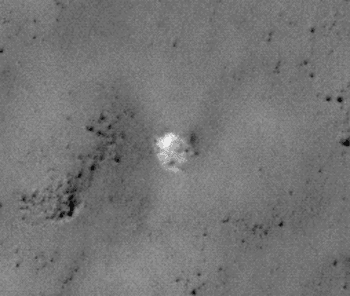
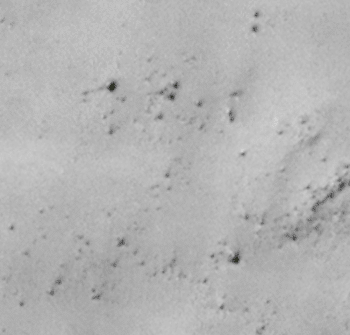
The new pictures look even paler because the sun is higher in the sky, shadow are shorter, and everything seems more flat.
Then we had a week to prepare the press release. This, by the way, emphasizes the ethics of NASA. They could have written their own release and not mentioned us. However, perhaps it's just the international principles of cooperation.
Our results of operations, searches, evidence and archival excavation are now on NASA's website.
And now on the next mystery: Mars-6 has not yet been found!
I would suggest to you readers that you could make a contribution to the history of the domestic space. It would be possible to join the crowd on the HiRISE website, review photos and find something suitable. But it would be more efficient to make an application for Android and iOS, which would allow you to view fragments of images and select the most interesting parts. Something like the project "Planet Four."
And, yes, none of this would have happened if it were not for my employers, who are called to Mars, and who turned a blind eye to the working time that I spent buried in the gray box of the HiRISE image.
[Phil Stooke has calculated the location of the putative lander to be 45.045 degrees south, 202.023 degrees east (157.977 degrees west).
It is proper for amateurs to be carrying out the searches for the other missing Martian hardware -- it's a place in which citizen enthusiasts can take on a task to yield a culturally important result, a search for which the professionals simply do not have the time. I hope that people who do so will follow Vitaliy's example for thoroughness, and I agree with him that a cooperative search is much more likely to yield success than a solitary one!]
Support our core enterprises
Your support powers our mission to explore worlds, find life, and defend Earth. You make all the difference when you make a gift. Give today!
Donate

 Explore Worlds
Explore Worlds Find Life
Find Life Defend Earth
Defend Earth


